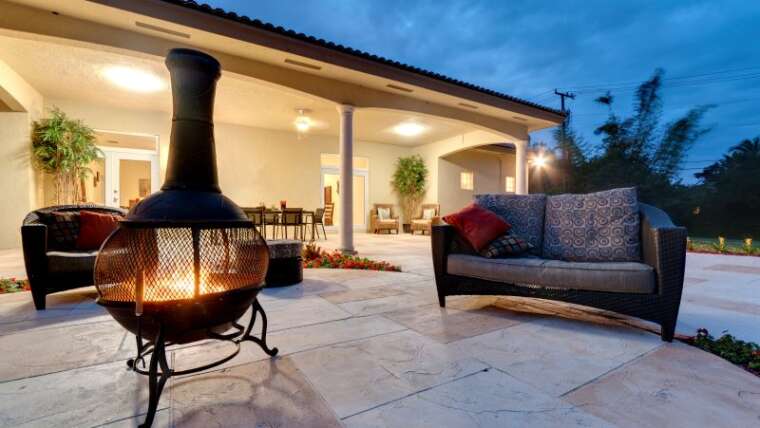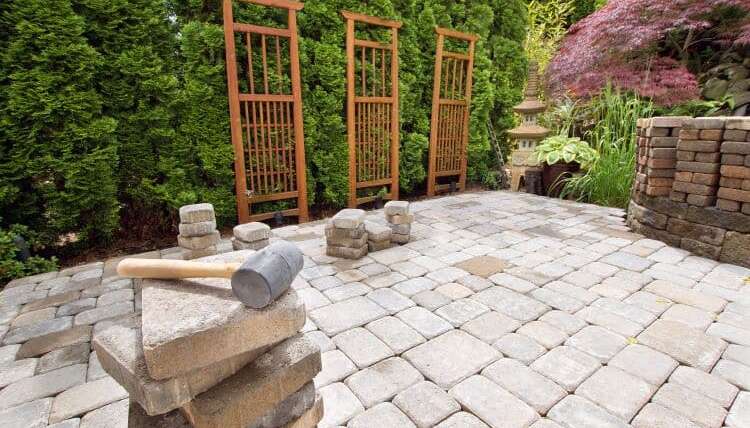Patios that look as if they’ve been in place since a home was built are the ones that see the biggest return on investment, according to experts.
That doesn’t mean you have to spend an arm and a leg, though. It also doesn’t mean your patio needs to be dingy to attract buyers. Whether you’re remodeling on a budget or have unlimited legroom, there are patios out there for you to choose from.
Luckily, we’re here to help you through the entire patio design process. Read on to learn everything you need to know.
Pick Your Place
While most patios sit adjacent to the house, it isn’t a must. In fact, an area placed well away from your home is a great way to create a private oasis. Place the grill out there or create an outdoor kitchen for a second dining space that feels like a restaurant right in your backyard.
Wherever the spot, you want to make sure it makes sense for your space. So, if you don’t want to create an outdoor kitchen but do want to use your patio as a dining space, it’d be smart to place it near the kitchen.
Size Things Out
Next, it’s important to size things properly. Your patio might be meant for family gatherings, but it can still be small and intimate.
However, if you plan on hosting large gatherings, you want to make sure the space can accommodate everyone. A simple way to gauge your patio’s ideal sizing would be to set tables and chairs out on your lawn to see how much room you might need.
Choose All Your Materials
If you want a trendy patio surface, the most common options are brick, slate, concrete, and flagstone. They’re usually used alone or in combination with one another. What you do want to ensure, however, is that everything is cohesive.
Matching things up with your home and the elements inside or outside of it is a great place to start. Choosing a smoother surface if you plan on setting chairs out or dining on your patio so nothing wobbles is another thing to keep in mind.
Select the Details
While a patio can be as simple as a slab of concrete or slate, there are other elements you can add to make things pop.
You can mix materials together to create visual interest on the ground, or you can bring in elements of lighting, fountains, fire, and also planters. Make things pop with colorful furniture or keep everything neutral for an earthy feel.
Ultimately, the elements you choose to incorporate have the power to make a big difference for your patio. So, it’s important to put some time and thought into how you’d like things to feel and look for the space as a whole.
Choose a Contractor
Next, you’ll need to decide just how much of this work can be completed by you and what you might need to hire someone to do. The weight and hardness of some materials can make things difficult, so it’s usually best to hire someone for tougher jobs like installing weighty pavers.
No matter what you choose to opt for professional help with, it’s important to ensure you’re hiring the right help. Be sure to conduct plenty of research before you make your decision, and ask your friends, family, or neighbors for recommendations if they’ve had any work done recently.
Plan Things Out
When you hire someone, they’re going to draw out a blueprint for your patio. They’ll walk you through everything before they move forward with the process, and you can approve or disapprove until you get the exact design you’d like.
If you’re not working with someone, though, we’d still suggest taking this step. Measure out the area you’re working with, and then draw a rough outline of the things you’re wishing to incorporate. If you have measurements for the specific elements you’re wanting to include, then now is the time to make sure they’ll fit within your design.
Another thing you should leave room for is plants. They have the power to bring a unique dimension to your patio, and they can be as colorful or as subtle as you’d like them to be.
Easy-care plants like succulents and other groundcover plants are great for patios, as they can handle heavy foot traffic and any rough weather they must deal with.
Water Feature
In sunny states like Florida, having a water feature to cool off can make a big difference during the hot summer months. You don’t have to be able to swim around to enjoy them, though. Just having the sound of running water in your yard is enough to calm anxiety and make your patio a truly tranquil space.
Don’t Forget Shade
Having some sort of cover over your patio is another essential. If you can add a screen for extra mosquito protection during the summer that’s ideal, but it’s not a must. Creating something that’s enjoyable for everyone is essential, though, and shade is a big part of that.
You can opt for a pergola for simple shade, or you can go for something more solid that’s capable of blocking out rain too. With the second option, you’ll be able to nestle into your favorite corner whether it’s rain or shine.
Planning Patios Doesn’t Have to Be Hard
Remember, the biggest thing to remember about planning patios is that it’s supposed to be fun. You’re creating a new space to enjoy in your home, and you shouldn’t have to stress yourself out over every small detail throughout the process. If you’re really stuck, though, you can always turn to the professionals.
That’s where we come in. Contact us today to get started.



